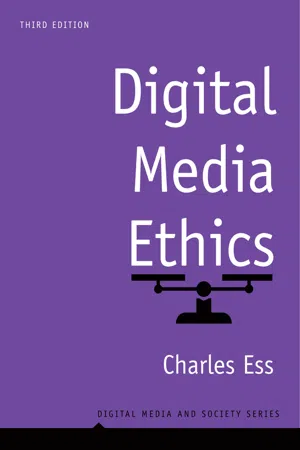Digital Media Ethics
About this book
The original edition of this accessible and interdisciplinary textbook was the first to consider the ethical issues of digital media from a global, cross-cultural perspective. This third edition has been thoroughly updated to incorporate the latest research and developments, including the rise of Big Data, AI, and the Internet of Things. The book's case studies and pedagogical material have also been extensively revised and updated to include such watershed events as the Snowden revelations, #Gamergate, the Cambridge Analytica scandal, privacy policy developments, and the emerging Chinese Social Credit System. New sections include "Death Online, " "Slow/Fair Technology", and material on sexbots. The "ethical toolkit" that introduces prevailing ethical theories and their applications to the central issues of privacy, copyright, pornography and violence, and the ethics of cross-cultural communication online, has likewise been revised and expanded. Each topic and theory are interwoven throughout the volume with detailed sets of questions, additional resources, and suggestions for further research and writing. Together, these enable readers to foster careful reflection upon, writing about, and discussion of these issues and their possible resolutions. Retaining its student- and classroom-friendly approach, Digital Media Ethics will continue to be the go-to textbook for anyone getting to grips with this important topic.
Frequently asked questions
- Essential is ideal for learners and professionals who enjoy exploring a wide range of subjects. Access the Essential Library with 800,000+ trusted titles and best-sellers across business, personal growth, and the humanities. Includes unlimited reading time and Standard Read Aloud voice.
- Complete: Perfect for advanced learners and researchers needing full, unrestricted access. Unlock 1.4M+ books across hundreds of subjects, including academic and specialized titles. The Complete Plan also includes advanced features like Premium Read Aloud and Research Assistant.
Please note we cannot support devices running on iOS 13 and Android 7 or earlier. Learn more about using the app.
Information
chapter one
Central Issues in the Ethics of Digital Media
Chapter overview
Case-study: Amanda Todd and Anonymous
Introduction
Table of contents
- Cover
- Contents
- Series title
- Title page
- Copyright page
- In memoriam
- Foreword by Luciano Floridi
- Preface to the Third Edition
- Acknowledgments
- 1 Central Issues in the Ethics of Digital Media
- 2 Privacy in the (Post-)Digital Era?
- 3 Copying and Distributing via Digital Media: Copyright, Copyleft, Global Perspectives
- 4 Friendship, Death Online, Slow/Fair Technology, and Democracy
- 5 Still More Ethical Issues: Digital Sex, Sexbots, and Games
- 6 Digital Media Ethics: Overview, Frameworks, Resources
- References
- Index
- End User License Agreement
